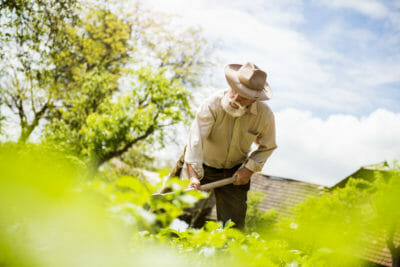[ad_1]
It’s a story most gardeners know all too well. We start off the growing season with a blank palette of natural soil in an atmosphere of spring optimism, always confident that this will be the best garden season ever. But if the arrival of summer brings with it an onslaught of weeds, even the most positive of spirits can get crushed under the weight of battling them.
The good news is that there are ways to combat weeds in spring, without using synthetic or even organic herbicides, which can make life a little more comfortable later on. Here are seven tricks to try.
Terminate Existing Weeds
Kill weeds first with clear plastic. Laying reusable clear plastic over the garden before planting any seeds is often an effective way to kill a lot of weeds at once. Sometimes, the greenhouse effect that is created by this method can generate so much heat that it destroys not only sprouted weeds but their seeds, as well, and possibly even other soil pathogens. As a nice side bonus, using clear plastic can preheat the soil in preparation for seeds or seedlings that will appreciate the residual warmth when the plastic is removed. One downside to this method is that it can be less effective in colder climates or during a cold, wet spring, and can end up creating favorable conditions for weed growth if the sun’s rays lack the intensity for searing heat. Make sure this one is right for your situation before using it.
Prepare For Planting
Use fabric mulch before or during planting. I buy high-quality landscape fabric by the roll—the heavy-duty kind sold by greenhouse supply outfits—as often as I can afford it. It costs me a lot more money up front than the cheap stuff, but it works out to be cost-effective because I use it over and over. I use it between the rows in my in-ground garden every year, laying it out before or during planting in a way that defines walk spaces and prevents weeds in all but the smallest slivers of soil. I also use fabric in long-term applications as a weed barrier between and around raised beds, and around berries and fruit trees.
Learn How To Plant A One Acre Survival Garden For Your Family
Less expensive fabric or recycled materials can also make a real difference in weeds. Some of my favorite re-purposed items for mulching are bags from livestock grain and other animal feed. Used carpet—especially around the other edges of a garden where any possible chemical seepage is less of an issue—works well, too.
Prevent Weed Regrowth
Use grass clippings, cardboard and newspaper. These are an excellent mulching option for smaller garden spaces and tight budgets. As with synthetic materials, it is essential to use this method before the weeds take hold—better still before they even sprout. I’ve used this mulching process with good results, and have found that the most important secrets to success are to do it on a day with little to no wind. Don’t skimp on materials, use heavy, wet grass clippings, and pack it down well.
Use weed-free compost. Whether purchased from a commercial compost facility or retailer, obtained directly from a farm, or made right on the homestead, the key is to ensure it’s been heated sufficiently to kill weed seeds. We get all the weeds we need from nature, and do not need to import more!
Maintain Soil Quality
Maintain the highest possible soil quality. Weeds flourish in poor soil, but most vegetables are not as adaptable as weeds. The more favorable conditions we can give our plants, the better armed they are to grow bigger and stronger and be better equipped to hold their own in the constant fight with weeds for space. Minimal rocks, the right ratio of sand and loam, ample organic material, and proper drainage all contribute to soil health—and in turn, make a big difference in plant health.
Provide plenty of water to newly planted seeds and seedlings. As with soil quality, water helps provide intentional plants with what they need to compete against weeds.
Nourish Plants
Provide the specific nutrients for the plants that you are growing. This point goes along with general soil quality and water but adds soil composition into the mix. It’s crucial to test garden soil—most cooperative extension services or state universities can help with this—and to amend the soil as recommended. Depending upon geography and the variety of crops being grown, soil test reports might advise raising or lowering soil pH, adjusting the ratio of organic matter, or adding specific nutrients like phosphorus, magnesium or sulfur.
The fundamental way to stop summer weeds in spring is twofold: First, make life as difficult as possible for weeds by overheating them in the sun under clear plastic or suffocating them under mulch. Second, make life as easy as possible for the plants you do want to grow by giving them the best possible soil and water conditions.
What advice would you add? Share it in the section below:
[ad_2]
Source link
Get more stuff like this
in your inbox
Don't Be Left Unprepared
Thank you for subscribing.
Something went wrong.




